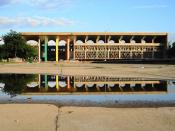Detailed book review, subject could also be French Architecture
Richard A. Etlin, Symbolic Space: French Enlightenment Architecture and Its Legacy. Chicago: The University of Chicago Press, 1994; xxv + 198 pp.; 113 ills.
Richard Etlin, in his study, Symbolic Space: French Enlightenment Architecture and Its Legacy, offers his insight into the integral relationship architecture has within the activities of man. Politics, science, social organization, and religion, all have spaces unique to their own functional character. Beyond a functional character, however, there exists a deeper, more spiritual connection man has with his surroundings. The emotional role of architecture is one focus of Etlin's work. In his treatment of emotion and its relevance in architecture, Etlin relates modern designs with those of the visionary French architects during the late eighteenth century.
In understanding the role of emotion, Etlin first establishes his notion of space. Mankind has the unique ability to control, design, and shape his environment to his needs.
"Architecture is concerned primarily with the creation of domains for human activity," Etlin writes. Apart from activity alone, architecture creates "spatial realms...with qualities that affect the viewer and the user." Architecture can establish a meaning and a feeling; it will affect man's mood. The mood is created and controlled by an architect's use and design of space. Etlin elaborates more on this idea of space, "All of these intellectual and subjective considerations about space, which reach beyond the mere measurement of height, width, and depth, and beyond the mere description of geometric features, are aspects of symbolic space." Symbolic space elevates architecture into something more cerebral and more personal than just the basic elements. It imparts the same notion and feeling of viewing a work of art, but allowing man more freedom; the freedom to use a work of art for his own...


